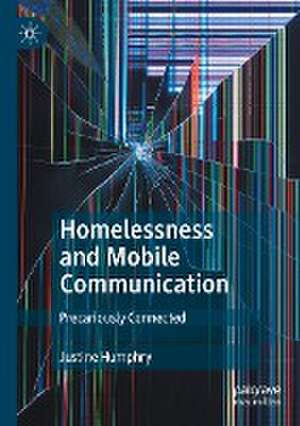Homelessness and Mobile Communication: Precariously Connected
Autor Justine Humphryen Limba Engleză Paperback – 22 oct 2023
| Toate formatele și edițiile | Preț | Express |
|---|---|---|
| Paperback (1) | 466.13 lei 6-8 săpt. | |
| Springer Nature Singapore – 22 oct 2023 | 466.13 lei 6-8 săpt. | |
| Hardback (1) | 640.71 lei 6-8 săpt. | |
| Springer Nature Singapore – 21 oct 2022 | 640.71 lei 6-8 săpt. |
Preț: 466.13 lei
Preț vechi: 548.38 lei
-15% Nou
Puncte Express: 699
Preț estimativ în valută:
89.20€ • 95.38$ • 74.37£
89.20€ • 95.38$ • 74.37£
Carte tipărită la comandă
Livrare economică 17 aprilie-01 mai
Preluare comenzi: 021 569.72.76
Specificații
ISBN-13: 9789811938405
ISBN-10: 9811938407
Pagini: 215
Ilustrații: XIII, 215 p.
Dimensiuni: 148 x 210 mm
Greutate: 0.28 kg
Ediția:1st ed. 2022
Editura: Springer Nature Singapore
Colecția Palgrave Macmillan
Locul publicării:Singapore, Singapore
ISBN-10: 9811938407
Pagini: 215
Ilustrații: XIII, 215 p.
Dimensiuni: 148 x 210 mm
Greutate: 0.28 kg
Ediția:1st ed. 2022
Editura: Springer Nature Singapore
Colecția Palgrave Macmillan
Locul publicării:Singapore, Singapore
Cuprins
Chapter 1 Introduction: meanings, mediations and models.- Chapter 2 Mobile lifelines in the lives of people who are homeless.- Chapter 3 ‘Second-class’ access: smartphone dependence and the mobile marketplace.- Chapter 4 Bearing the burden: digitisation of government, health and welfare.- Chapter 5 Precarious mobilities: homelessness and digital access in urban space.- Chapter 6 Policing homelessness: ‘smart’ cities and algorithmic governance.- Chapter 7 Conclusion: Is there anyone home?
Notă biografică
Dr Justine Humphry is a Senior Lecturer in Digital Cultures at the University of Sydney (Australia). Her research examines the cultural and political implications of digital media in everyday life and the lived realities of techno-marginalisation. A key concern of her research is the consequences of mobile, smart and datadriven technologies for under-represented and excluded communities.
Textul de pe ultima copertă
This book examines how mobile phones and the internet have become a vital part of the everyday lives of people experiencing homelessness. But the access mobile phones provide is costly, insecure and limited, producing an experience of being precariously connected. Drawing on findings of research conducted with over one hundred young people, families and adults experiencing homelessness in Australia and the United States, this book analyses homelessness as a mediated condition and explores the underpinning processes that shape digital disparities. It contributes to scholarship on mobile communication and inequality, highlighting the digital patterns, issues and difficulties of a group disproportionately affected by service reform and developments in digital citizenship, smart cities and algorithmic governance.
Caracteristici
Provides timely insights and evidence on an understudied population in mobile communication scholarship Reveals new understandings about contemporary homelessness and inequality in a society premised on digital connectivity Contributes to existing theories of precarity and to research on the dynamics of digital inclusion and exclusion
